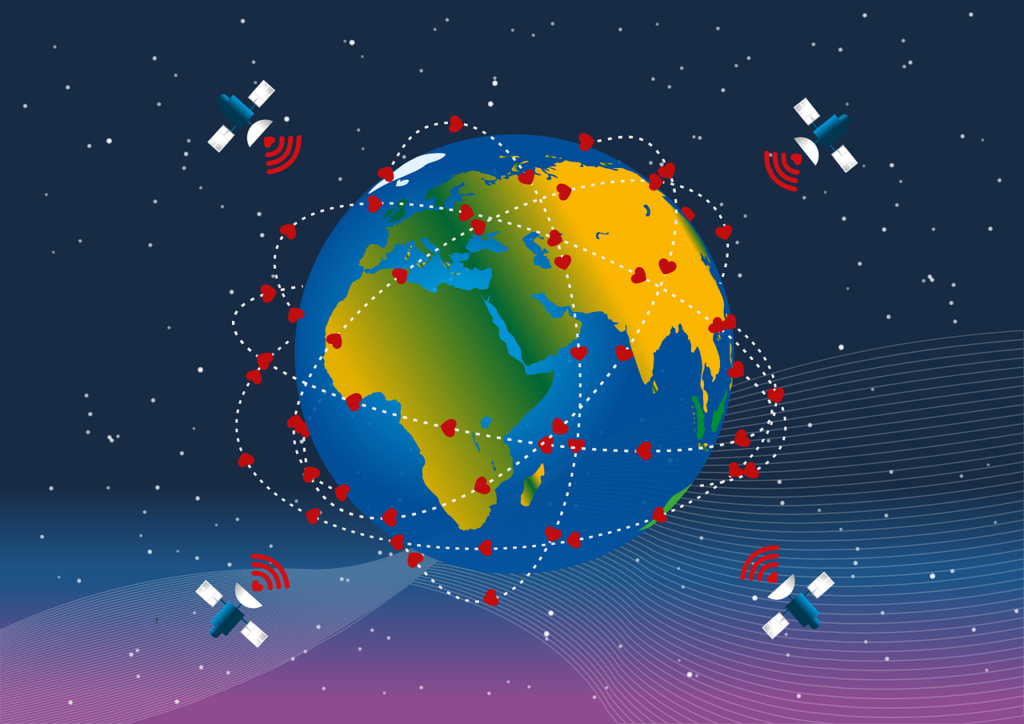Without electromagnetic radiation, wireless communication cannot be possible. We all are surrounded by electromagnetic radiation such as while using cell phones, the internet(Wi-Fi routers), object scanners, radio signals, walkie-talkie, signal jammers, etc. We cannot see electromagnetic radiation(except visible rays) but they exist around us. Communication devices rely on electromagnetic radiation for wireless communication.
Key Highlights:
- Wireless communication technology like the internet, Bluetooth, radio, satellite television, etc. use electromagnetic radiation to transmit and receive data
- Electromagnetic radiation is everywhere; sunlight consists of ultraviolet rays and infrared rays along with visible light
- Every matter(living or non-living) possesses internal energy and emits/loses energy in the form of radiation mainly infrared rays(also known as heat waves)
- A microwave oven we use to reheat food uses microwave and infrared radiation
- The speed of electromagnetic radiation is equal to the speed of light that is 299,792,458 m/s(~3 x 108 ms-1)
- The electromagnetic spectrum has 7 types of electromagnetic waves
- Famous Scientist and Mathematician James Clerk Maxwell laid the foundation stone for electromagnetic radiation through his equations known as Maxwell’s equations for electromagnetic waves
- Electromagnetic waves possess energy; high-intensity radiations can harm living cells. X-rays can even alter the function of our cell and gamma rays ionizes cells and tissues altering DNA
Introduction
The discovery of electromagnetic radiation in the nineteenth and twentieth centuries is the reason for the advancement of modern wireless communication. We are able to access fast internet and transmit large amounts of digital data due to the continuous improvement in the wireless communication infrastructure and digital devices like smartphones, PCs, and other wearable devices.
Whatever wireless communication we have heard of uses one of the seven types of electromagnetic waves: radio waves, microwaves, infrared radiation, visible light, ultraviolet radiation, X-rays, and gamma rays.
For example, Bluetooth wireless technology uses ultra-high frequency (UHF) radio waves with a frequency of 2.4 GHz. Even WiFi routers use UHF radio waves ranging from 2.4 GHz to 5 GHz to 6 GHz depending on the application. The TV remote and microwave oven use infrared radiation to interact with the TV and to heat the food respectively.
Another example is microwaves used for satellite and spacecraft communication as microwaves can easily pass Earth’s atmosphere. The frequency of satellite communication varies depending on the communication band connected to the application device. The Global Positioning System (GPS) works in the L-band.
The satellite telecommunication currently has 6 communication bands; L-band (1–2 GHz), S-band (2–4 GHz), C-band (4–8 GHz), X-band (8–12 GHz), Ku-band (12–18 GHz), and Ka-band (26–40 GHz).
What is the frequency and wavelength of an electromagnetic wave?
The frequency of an electromagnetic wave is the number of cycles completed per second. The unit of frequency is Hertz(Hz).
For example, if the frequency of a wave is 1KHz, the wave has completed 1000 cycles in one second.
The wavelength of an electromagnetic wave is the distance between the two successive peaks(also called crests) of the wave.
The unit of wavelength is meter(m).
The frequency and wavelength are inversely proportional to each other.
Frequency ∝ (wavelength)-1 or
f ∝ 1/λ
Through experiments, it has been proved that electromagnetic waves travel at the speed of light which is 299,792,458 m/s(~3 x 108 ms-1).
The electromagnetic spectrum consists of different types of waves with varying frequency(f) and wavelength(λ). All electromagnetic waves obey one important equation; When the frequency and wavelength of any electromagnetic wave are multiplied it equals the speed of light(c) or gives a constant value of c= 3 x 108 ms-1.
That is for any electromagnetic waves,
frequency(f) x wavelength(λ) = speed of light(c)
or c= fλ
What is Electromagnetic spectrum?
The electromagnetic spectrum is the range of distribution of all electromagnetic radiations that exist based on their frequency or wavelength.
There are 7 types of electromagnetic radiation commonly called electromagnetic waves or electromagnetic rays.
1. Radio waves
The frequency(f) range of radio waves is from 3 KHz to 300 GHz and wavelength(λ) ranges from 1 mm to up to 100 kms.
The existence of radio waves was first proved by Physicist Heinrich Hertz in the 1800s at the Karlsruhe Institute of Technology. Hertz produced and detected radio waves in his laboratory by using two separate spark gaps one attached to an induction coil and another on a receiving antenna.
Hertz also proved that these waves possessed the properties of electromagnetic waves, hence radiowaves were discovered.
The unit of frequency that is ‘Hertz’ is named after him.
Nikola Tesla was the first to attempt to transmit powerful radio waves using his Tesla coils to long distances using a transmitter and receiver in 1895. But he couldn’t as his infrastructure was hit by a disaster in New York that ruined his lab.
On the other side, Italian scientist Guglielmo Marconi was working to build wireless telegraphy in England. On 12th December 1901 Marconi succeeded in transmitting a message via radio signal from Cornwall in England to St. John’s, Newfoundland.
Huge celestial objects that have varying magnetic fields produce radio waves.
Radiowaves find applications in radio broadcasting, cellular networks, satellite communication, etc.
2. Microwaves
The frequency of microwaves ranges from 1 GHz to over 300 GHz and wavelength from wavelength from 30cm to 0.03 cm.
Microwave radiation is used in satellite communication like Global Positioning System (GPS), weather forecasting, and sending signals to a ground station. Microwave rays can penetrate through clouds, dust, smoke, and snow.
3. Infrared rays
Infrared ray frequency ranges from 300 GHz to 400 THz and the wavelength between 780 nm and 1 mm.
Sir Frederick William Herschel discovered infrared radiation in 1800 while performing an experiment to know how much heat was passed through different colored filters he used to observe light.
Infrared rays find application in our daily household devices like remotes, ovens, sensors, alarm systems, CCTV, night vision cameras, etc
4. Visible rays
Visible rays or visible light have a frequency from 400 THz to 800 THz and a wavelength from 400 nm to 700 nm.
The existence of visible light was first discovered in the 13th century by Roger Bacon but the range of wavelength of visible light spectrum was discovered by Isaac Newton in the 17th century.
Newton in his prism experiment experiment showed that the visible light/white light spectrum is a mixture of red, orange, yellow, green, blue, indigo, and violet. The wavelength of the visible light spectrum is 400 to 700 nm.
The human eye can detect visible light with wavelength ranging from about 390 to 700 nm.
5. Ultraviolet rays
Ultraviolet radiation has a frequency range between 800 THz and 30,000 THz and a wavelength between 10 nm and 400 nm.
Johann Wilhelm Ritter discovered ultraviolet radiation on 22 February 1801 while experimenting to investigate the existence of rays beyond the visible spectrum.
Do you know bees, some birds, reptiles, and insects can see UV rays because they have short blue cones?
Different frequencies of UV rays have different applications. Ultraviolet rays are widely used in industrial and medical fields such as killing bacteria and germs, phototherapy, suntanning, creating fluorescent effects, curing resins, etc.
6. X-rays
X-rays have a frequency range from 30 PHz to 30 EHz and wavelength from 0.01 nm to 10 nm.
Wilhelm Conrad Roentgen discovered X-rays in 1895 while working with a cathode ray tube in his laboratory. X-rays have a shorter wavelength compared to visible light which makes them easily penetrate through the material. X-rays are so powerful that they can break chemical bonds in the material they penetrate and in living beings they can change the function of the cells.
X-rays are used in X-ray radiography and mammography. X-ray radiography is used to detect bone fractures, tumors, pneumonia, certain types of injuries, foreign objects, and dental problems.
7. Gamma-rays
Gamma rays have a frequency above 30 EHz and a frequency shorter than 10-11 meters.
Paul Villard discovered gamma rays in 1900 while studying radiation emitted by radium. In 1896 Henri Becquerel discovered natural radioactivity.
Gamma rays are the most powerful radiation emitted by the decay of atomic nuclei. They can damage the cells in living beings and damage the DNA sequence. Exposure to such powerful radiation can cause skin diseases and skin cancer.
Gamma rays are used in radiotherapy, sterilization, and disinfection.
Gamma rays are continuously emitted by our sun, and stars and also during cosmic events like gamma-ray bursts. But our Earth possesses natural atmospheric and magnetic shields that protect us from these types of cosmic radiation by reflecting them back. The Earth’s magnetic fields are produced due to the presence of molten metals in the Earth’s core.
How does Earth look in different radiations?
How Electromagnetic Radiations are produced?
Electromagnetic radiations are produced when a charged particle like an electron/proton accelerates or decelerates.
The acceleration or deceleration of an electron is the result of oscillating electric and magnetic disturbance.
In the 1860s famous Scientist James Clerk Maxwell noticed both electrical and magnetic fields can couple together can form electromagnetic waves. He developed the theory of electromagnetic radiation and formed the basic equations.
Later in 1888 Physict Henrich Hertz transmitted and detected electromagnetic waves based on Maxwell’s equation.
Visualizing the production of electromagnetic radiation is difficult and tedious, watch the below-embedded video on electromagnetic radiation.
Radiation Integrals:
The embedded Instagram post below gives a glance at radiation integrals using Maxwell’s equation.
Conclusion:
Electromagnetic radiation is everywhere, we are surrounded by them but cannot see. Because of them, we are able to use wireless communication like cell phones in any part of the world. The high-speed radiation and superfast processing of data in digital devices has made our life much easier. Wireless communication like video calls and voice call happen in real time. With the help of electromagnetic waves, our scientists are able to operate the Mars Rover sitting from the Earth which is 225 million km away. There are 7 types of electromagnetic rays in the electromagnetic spectrum and are classified based on their frequency and wavelength.
Electromagnetic rays can be a threat to human life if they possess high energy. Wireless communication devices like smartphones and antennas emit radiation with energy below the prescribed safe level. Specific Absorption Rate (SAR) is used to measure the energy absorption by tissues. The Department of Telecommunication India has approved the prescribed limit for the safe use of mobile phones to a SAR value of 1.6 W/Kg for 1 gm tissue.
Useful Glossary –
1. Ionization – A process in which an atom/molecule becomes negatively/positively charged by gaining/losing an electron. When ionized, A charged subatomic particle can penetrate through matter through radiation.




Pingback: Birth of photons(light rays) inside sun's core